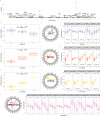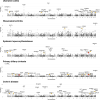Natural Killer cells demonstrate distinct eQTL and transcriptome-wide disease associations, highlighting their role in autoimmunity
- PMID: 35835762
- PMCID: PMC9283523
- DOI: 10.1038/s41467-022-31626-4
Natural Killer cells demonstrate distinct eQTL and transcriptome-wide disease associations, highlighting their role in autoimmunity
Abstract
Natural Killer cells are innate lymphocytes with central roles in immunosurveillance and are implicated in autoimmune pathogenesis. The degree to which regulatory variants affect Natural Killer cell gene expression is poorly understood. Here we perform expression quantitative trait locus mapping of negatively selected Natural Killer cells from a population of healthy Europeans (n = 245). We find a significant subset of genes demonstrate expression quantitative trait loci specific to Natural Killer cells and these are highly informative of human disease, in particular autoimmunity. A Natural Killer cell transcriptome-wide association study across five common autoimmune diseases identifies further novel associations at 27 genes. In addition to these cis observations, we find novel master-regulatory regions impacting expression of trans gene networks at regions including 19q13.4, the Killer cell Immunoglobulin-like Receptor region, GNLY, MC1R and UVSSA. Our findings provide new insights into the unique biology of Natural Killer cells, demonstrating markedly different expression quantitative trait loci from other immune cells, with implications for disease mechanisms.
© 2022. The Author(s).
Conflict of interest statement
The authors declare no competing interests.
Figures




Similar articles
-
Functional genomics implicates natural killer cells in the pathogenesis of ankylosing spondylitis.HGG Adv. 2025 Jan 9;6(1):100375. doi: 10.1016/j.xhgg.2024.100375. Epub 2024 Oct 28. HGG Adv. 2025. PMID: 39468794 Free PMC article.
-
Polarization of the effects of autoimmune and neurodegenerative risk alleles in leukocytes.Science. 2014 May 2;344(6183):519-23. doi: 10.1126/science.1249547. Science. 2014. PMID: 24786080 Free PMC article.
-
Combining genetic mapping with genome-wide expression in experimental autoimmune encephalomyelitis highlights a gene network enriched for T cell functions and candidate genes regulating autoimmunity.Hum Mol Genet. 2013 Dec 15;22(24):4952-66. doi: 10.1093/hmg/ddt343. Epub 2013 Jul 29. Hum Mol Genet. 2013. PMID: 23900079 Free PMC article.
-
Significance of KIR like natural killer cell receptors in autoimmune disorders.Clin Immunol. 2020 Jul;216:108449. doi: 10.1016/j.clim.2020.108449. Epub 2020 May 3. Clin Immunol. 2020. PMID: 32376502 Review.
-
The genetic basis of autoimmunity seen through the lens of T cell functional traits.Nat Commun. 2024 Feb 8;15(1):1204. doi: 10.1038/s41467-024-45170-w. Nat Commun. 2024. PMID: 38331990 Free PMC article. Review.
Cited by
-
Identifying genetic variants that influence the abundance of cell states in single-cell data.bioRxiv [Preprint]. 2023 Nov 15:2023.11.13.566919. doi: 10.1101/2023.11.13.566919. bioRxiv. 2023. Update in: Nat Genet. 2024 Oct;56(10):2068-2077. doi: 10.1038/s41588-024-01909-1. PMID: 38014313 Free PMC article. Updated. Preprint. No abstract available.
-
Granulysin-high decidual NK cells in macaques and humans share signatures of immune defense.Cell Rep. 2025 Jul 22;44(7):115943. doi: 10.1016/j.celrep.2025.115943. Epub 2025 Jul 8. Cell Rep. 2025. PMID: 40638390 Free PMC article.
-
Functional genomics implicates natural killer cells in the pathogenesis of ankylosing spondylitis.HGG Adv. 2025 Jan 9;6(1):100375. doi: 10.1016/j.xhgg.2024.100375. Epub 2024 Oct 28. HGG Adv. 2025. PMID: 39468794 Free PMC article.
-
Genome-wide association study of leprosy in Malawi and Mali.PLoS Pathog. 2022 Sep 19;18(9):e1010312. doi: 10.1371/journal.ppat.1010312. eCollection 2022 Sep. PLoS Pathog. 2022. PMID: 36121873 Free PMC article.
-
Functional genomics implicates natural killer cells in the pathogenesis of ankylosing spondylitis.medRxiv [Preprint]. 2024 May 9:2023.09.21.23295912. doi: 10.1101/2023.09.21.23295912. medRxiv. 2024. Update in: HGG Adv. 2025 Jan 09;6(1):100375. doi: 10.1016/j.xhgg.2024.100375. PMID: 37808698 Free PMC article. Updated. Preprint.
References
Publication types
MeSH terms
Substances
Grants and funding
LinkOut - more resources
Full Text Sources
Medical

